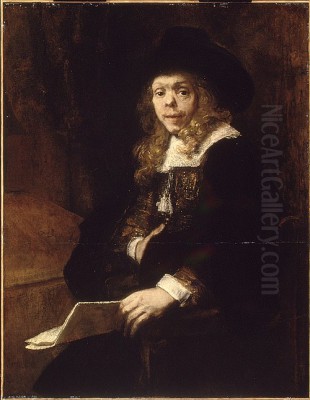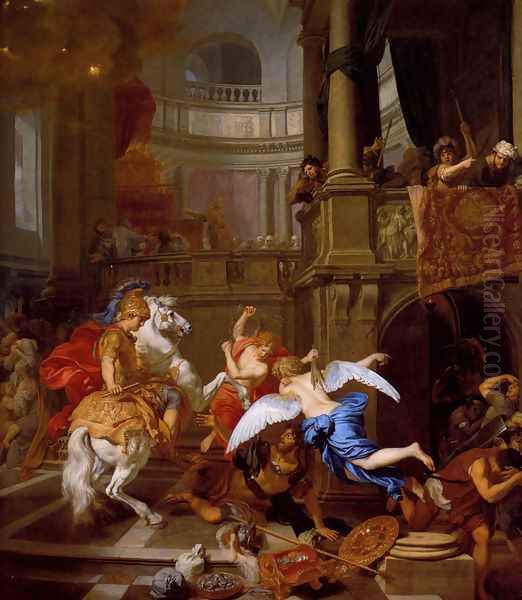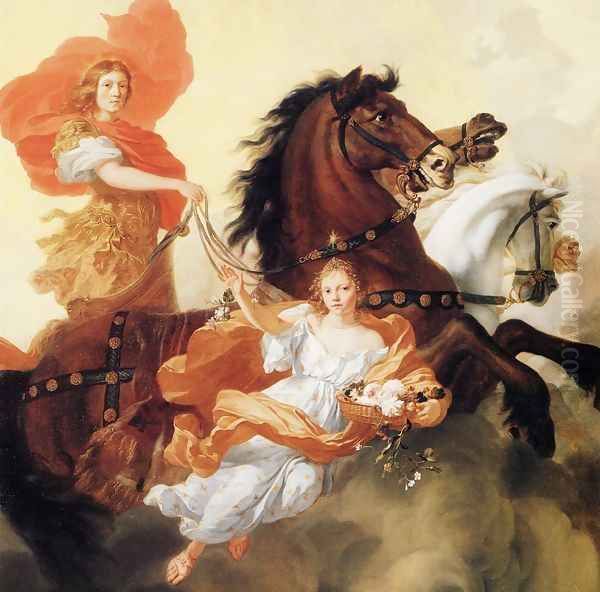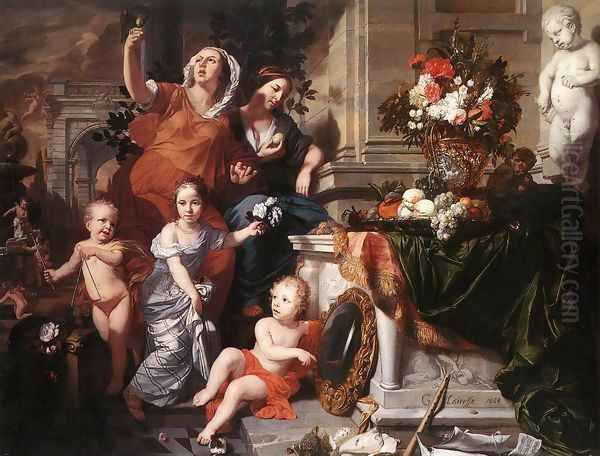
Gerard de Lairesse stands as a significant, albeit sometimes debated, figure in the rich tapestry of the Dutch Golden Age. Active during the latter half of the 17th and the early 18th centuries, he was not only a prolific painter and printmaker but also an influential art theorist whose ideas shaped artistic discourse long after his death. Born in Liège in the Southern Netherlands (present-day Belgium), he later found fame and fortune in Amsterdam, becoming a leading proponent of a classicizing style that offered a distinct alternative to the prevailing trends associated with artists like Rembrandt. His career embodies the international currents flowing through Dutch art and the enduring appeal of classical ideals.
From Liège to Amsterdam: Early Life and Formation
Gerard de Lairesse was born in Liège, likely in 1641 (though some sources cite 1640). His artistic education began under his father, Renier de Lairesse, also a painter. The young Gerard showed considerable talent early on, absorbing the artistic traditions of his native region, which maintained strong ties to French and Italian art. Further training likely occurred within Liège and possibly involved exposure to French artistic trends, laying the groundwork for his later stylistic preferences. His early life, however, was marked by a dramatic turn of events.
Around 1664, Lairesse was compelled to leave Liège abruptly. Contemporary accounts and later biographers point to a "scandal" or an "affair of the heart" involving two sisters, possibly leading to a duel or other complications. He fled northwards, accompanied by Marie Salme, who would become his wife. Their journey initially took them to Utrecht. It was during this period of uncertainty, possibly while undertaking modest work like painting signs to make ends meet, that his exceptional talent was recognized.
His fortunes changed significantly upon reaching Amsterdam around 1665. There, he came into contact with the influential art dealer Gerrit van Uylenburgh. Van Uylenburgh operated a large workshop and dealership, employing many artists and playing a crucial role in the Amsterdam art market. Recognizing Lairesse's skill and distinct style, Van Uylenburgh provided him with opportunities and helped establish his reputation in the bustling metropolis, effectively launching his successful Dutch career.
Forging a Classical Path in Amsterdam

Lairesse arrived in an Amsterdam where the art scene had been profoundly shaped by Rembrandt van Rijn and his followers, known for their dramatic use of light and shadow (chiaroscuro), expressive brushwork, and deep psychological insight. Lairesse, however, offered something different. His artistic vision was firmly rooted in the classical tradition, drawing inspiration from antiquity and the High Renaissance, as well as contemporary French classicism, particularly the work of Nicolas Poussin and Charles Le Brun.
His style emphasized clarity of composition, idealized human forms, smooth finishes, bright lighting, and rich colours. He favoured subjects drawn from classical mythology, ancient history, biblical narratives, and complex allegories. This approach appealed greatly to the wealthy burghers and regents of Amsterdam, who increasingly favoured elegance, intellectual sophistication, and decorum in the art adorning their grand townhouses and public institutions. Lairesse quickly became one of the most sought-after painters in the city for large-scale decorative projects.
His success marked a shift in taste occurring in the later Dutch Golden Age, moving away from the more typically 'Dutch' realism and dramatic intensity of the mid-century towards a more international, refined, and academically informed classicism. Lairesse was perfectly positioned to cater to this evolving aesthetic preference, earning him considerable fame and numerous prestigious commissions.
The Painter of History and Allegory
Lairesse excelled in history painting, considered the noblest genre according to academic theory, which he himself would later champion in his writings. His works often depicted complex narratives requiring intellectual engagement from the viewer. He embraced the classical ideal of ut pictura poesis – "as is painting, so is poetry" – believing that painting, like literature, should instruct and delight, conveying moral or philosophical messages through visual narratives.
His compositions are typically well-ordered, often set within elaborate classical architectural frameworks. Figures are gracefully posed, their gestures and expressions carefully calibrated to convey the story's emotional content according to classical principles of decorum. Unlike the often turbulent and emotionally raw scenes found in Rembrandt's work, Lairesse aimed for harmony, balance, and intellectual clarity. His use of light is generally even and bright, illuminating the scene clearly rather than creating deep shadows and mystery.
His subject matter frequently involved intricate allegories, drawing upon sources like Cesare Ripa's Iconologia, a famous emblem book that provided artists with standardized ways to represent abstract concepts visually. This appealed to patrons who valued erudition and enjoyed deciphering the layers of meaning embedded within the artwork. Lairesse became the pre-eminent painter of such intellectually demanding subjects in the Dutch Republic.
Masterpieces in Paint

Throughout his productive career, Lairesse created numerous significant works, many of which were large-scale commissions for specific locations. Among his most celebrated paintings are:
The Banquet of Cleopatra (c. 1675-1680, Rijksmuseum, Amsterdam): This large canvas depicts the famous story from Plutarch where the Egyptian queen dissolves a priceless pearl in vinegar to win a wager against Mark Antony. The scene unfolds in a grand, classical setting, showcasing Lairesse's skill in handling complex multi-figure compositions, luxurious textures, and historical detail. It exemplifies his mature classical style, combining narrative clarity with opulent display.
The Expulsion of Heliodorus from the Temple (c. 1674): Based on a story from the Second Book of Maccabees, this painting portrays the dramatic moment when Heliodorus, sent to seize treasure from the Temple in Jerusalem, is driven out by divine intervention. Lairesse captures the dynamism and divine power of the event within a meticulously rendered architectural space, demonstrating his ability to handle complex action and convey strong emotions within a classical framework.
Apollo and Aurora (c. 1671, Metropolitan Museum of Art, New York): This work depicts the sun god Apollo beginning his daily journey across the sky, accompanied by Aurora, the goddess of dawn. It is a prime example of Lairesse's mythological paintings, characterized by graceful figures, luminous colours, and an overall sense of elegance and harmony. The idealized forms and bright palette are typical of his adherence to classical aesthetics.
Beyond easel paintings, Lairesse was particularly renowned for his decorative schemes, including ceiling paintings and wall hangings designed for the interiors of wealthy Amsterdam residences, such as the Trippenhuis, and public buildings like the Lepers' Hospital and potentially the Binnenhof (Court of Justice) in The Hague. These often employed trompe-l'oeil (deceive the eye) techniques, creating illusions of architectural vistas or mythological scenes unfolding above the viewer, integrating art seamlessly with the surrounding space.
Lairesse the Etcher
In addition to his paintings, Gerard de Lairesse was also a skilled and prolific etcher. His prints often reproduced his own painted compositions, helping to disseminate his style and iconography more widely. He also created original print designs, exploring similar themes of mythology, allegory, and history. His etching technique shows clarity and precision, aligning with his overall classical aesthetic.

In his printmaking, one can sometimes see the influence of earlier masters of Dutch printmaking, such as Hendrick Goltzius, known for his technical virtuosity and classical subjects. Lairesse's prints, like his paintings, served both decorative and didactic purposes, often illustrating complex narratives or allegorical concepts with remarkable detail and compositional skill. They form an important part of his oeuvre, reflecting his versatility as an artist.
The Theorist: Codifying Art
Perhaps Lairesse's most enduring legacy lies in his work as an art theorist. Towards the end of his career, particularly after he went blind around 1690, he dedicated himself to teaching and dictating his principles of art. This resulted in two highly influential books: Grondlegginge ter Teekenkonst (Foundations of Drawing), published in 1701, and the monumental Het Groot Schilderboek (The Great Book of Painting), published in 1707.
The Grondlegginge ter Teekenkonst served as a systematic drawing manual. It emphasized the importance of geometry, proportion, perspective, and anatomy as the essential foundations for any aspiring artist. Lairesse provided clear rules and examples, aiming to establish drawing as a rational, teachable discipline based on sound principles, moving away from mere imitation towards a more intellectual understanding of form.
Het Groot Schilderboek was far more comprehensive, intended as a complete guide to the art of painting. Divided into thirteen books, it covered virtually every aspect of the profession, from invention (choosing subjects) and composition (arranging figures and elements) to expression (depicting emotions), colour theory, and the handling of light and shadow. It strongly advocated for the hierarchy of genres, placing history painting at the pinnacle due to its intellectual demands and moral purpose.
Lairesse's theoretical works are prescriptive, laying down strict rules for achieving 'good' painting based on classical ideals and the examples of masters like Raphael, Poussin, and classical sculpture. He explicitly criticized styles he deemed incorrect or inferior, often targeting the realism and perceived lack of decorum in the works of Rembrandt and his followers, whom he accused of preferring the "ugly" and "common" over the "beautiful" and "noble." His reliance on classical sources and authorities like Cesare Ripa for understanding allegory is evident throughout the text.
These books became enormously influential, especially during the 18th century. They were translated into German, French, and English, serving as standard textbooks in art academies across Europe. Artists like Jacob de Wit, a leading Dutch decorative painter of the next generation, were profoundly influenced by Lairesse's theories and style. His writings codified the principles of academic classicism for a wide audience.
A Network of Artists: Influences and Interactions

Gerard de Lairesse operated within a vibrant artistic community, interacting with, influencing, and being influenced by numerous contemporaries. His relationship with the towering figure of Rembrandt van Rijn is particularly noteworthy. While some early works by Lairesse might show a subtle awareness of Rembrandt's chiaroscuro or expressive power, Lairesse consciously defined his mature style in opposition to Rembrandt's. Rembrandt himself painted a striking portrait of the young Lairesse around 1665, capturing his features already marked by the congenital syphilis that would later afflict him severely. Lairesse's later theoretical writings contain thinly veiled criticisms of Rembrandt's approach.
The French masters Nicolas Poussin and Charles Le Brun were far more significant positive influences. Lairesse deeply admired Poussin's intellectual approach to history painting and Le Brun's role in codifying academic classicism at the French Royal Academy. Lairesse effectively became the leading exponent of this Franco-Italian classical tradition in the Dutch Republic, earning him nicknames like the "Dutch Poussin."
Other artists played roles in his development or circle. Early exposure might have included the works of French Baroque painters like Simon Vouet. His printmaking shows an awareness of predecessors like Hendrick Goltzius. The theories of the Italian iconographer Cesare Ripa were fundamental to his allegorical works and writings. While perhaps less direct, he worked within the broader context of Dutch art, which included masters of genre and interior scenes like Pieter de Hooch.
Lairesse's arrival in Amsterdam was facilitated by the dealer Gerrit van Uylenburgh. He also ran a workshop and had several pupils and assistants, including Jan van Mieris, Philip Tideman, and possibly Johannes Glauber, who sometimes painted landscape backgrounds in his history scenes. His own family was deeply involved in art: his father Renier de Lairesse, his brothers Jacques de Lairesse and Jan Gerard de Lairesse, and his sons Jan de Lairesse and Abraham de Lairesse (though sources sometimes mention a Jacques instead of Abraham) were also artists, often working in styles related to his own. He may also have interacted with figures like Jan van Peen and Anthonie Claesz de Geer, mentioned in connection with him. The French playwright Jean Racine is also mentioned as an influence, perhaps reflecting Lairesse's own interest in drama and classical narrative structure.
Illness, Resilience, and Later Life
Lairesse's life was profoundly affected by congenital syphilis, a disease likely inherited at birth. The illness caused noticeable facial disfigurement (a "saddle nose," visible in Rembrandt's portrait) and other health problems throughout his life. Around 1690, the disease tragically led to blindness, effectively ending his career as a painter and etcher.
However, Lairesse demonstrated remarkable resilience. Unable to paint, he shifted his focus entirely to teaching and art theory. He gathered students around him, delivering lectures that formed the basis of his two major theoretical publications, which were dictated to his sons or assistants. This period cemented his reputation as a leading intellectual figure in the Dutch art world.
Anecdotes suggest that in his later years, perhaps burdened by his affliction or seeking spiritual solace, he adopted a more introspective lifestyle and may have even sought refuge for a time in a Dominican monastery. His Catholic background, somewhat unusual in predominantly Calvinist Amsterdam, might have played a role in his worldview and possibly influenced his choice of certain religious subjects. Gerard de Lairesse died in Amsterdam in 1711, leaving behind a substantial body of work and highly influential theoretical writings.
Fluctuating Fortunes: Lairesse's Legacy
In the late 17th and throughout the 18th century, Gerard de Lairesse was held in extremely high regard. He was considered one of the greatest artists of the Dutch Golden Age, praised for his elegance, erudition, and adherence to timeless classical principles. His Groot Schilderboek was indispensable reading for artists and connoisseurs alike, shaping artistic education and taste across Europe. His influence extended far, with evidence suggesting his books even reached Japan during the Edo period via Dutch traders, impacting aspects of Japanese Western-style painting.
However, the rise of Romanticism in the late 18th and 19th centuries brought a dramatic shift in artistic values. Lairesse's emphasis on rules, reason, and idealized forms came to be seen as cold, academic, and artificial. Critics began to champion the emotional intensity, realism, and perceived 'naturalness' of artists like Rembrandt, Frans Hals, and Jan Steen. Lairesse's reputation plummeted, and he was often dismissed as a mere imitator of foreign styles, even blamed for the perceived decline of Dutch painting after the Golden Age.
The 20th and 21st centuries have witnessed a more balanced reassessment of Lairesse's contribution. Art historians now recognize his importance as a major representative of the international classical movement within the Netherlands. His paintings are appreciated for their technical skill, compositional harmony, and intellectual depth. His theoretical writings are studied as crucial documents of late Baroque art theory and academic practice. Major exhibitions, such as one held at the Rijksmuseum Twenthe in 2016, have helped to reintroduce his work to a wider public and solidify his place in art history. His works remain in prestigious collections worldwide, including the Rijksmuseum, the Louvre, the Metropolitan Museum of Art, and numerous others.
Conclusion
Gerard de Lairesse occupies a unique and significant position in Dutch art history. He was both a highly successful painter, mastering the classical style favoured by the elite of his time, and a profoundly influential theorist who sought to codify the rules of art for future generations. While his reputation has ebbed and flowed with changing artistic tastes, his role as a key proponent of classicism in the later Dutch Golden Age is undeniable. His life, marked by early drama, professional success, personal adversity, and intellectual resilience, produced a body of work and theoretical ideas that significantly impacted the course of European art. He remains a testament to the diversity of the Dutch Golden Age and the enduring power of the classical tradition.